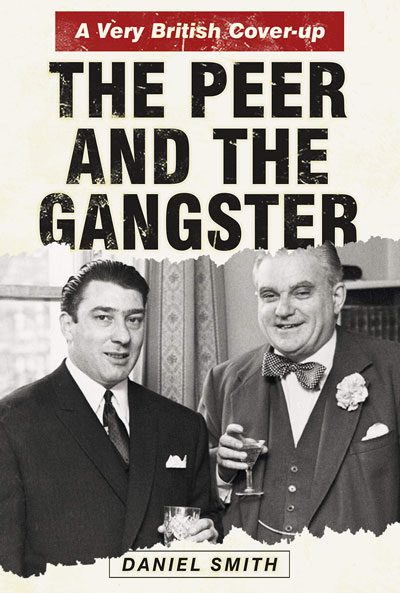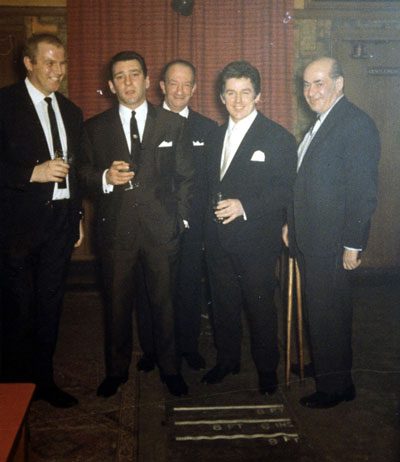Our book review for January is The Peer and the Gangster by Daniel Smith (The History Press)

by John Morris
In the last 12 months, there has been considerable focus on rumours of corruption involving the royal family, politicians and other public figures. This intriguing and gripping novel tells you the story of Lord Boothby and his links to the Kray crime family in 1960s London.
The Blind Beggar Pub
I taught physical education in a large secondary school on the Portobello Road in the mid-1960s. On many a Friday night, my friends and I would call for a pint at the Blind Beggar pub on the Whitechapel Road, on our way to a social club at the London Hospital.
On our first visit to the Blind Beggar, we realised this was where on March 9th 1966, Ronnie Kray had shot George Cornell in the head whilst he was sitting in the saloon bar. A plaque on the wall even showed where the bullet had gone through Cornell’s head. George Cornell was an associate of the Richardsons, a rival gang to the notorious Kray twins. The two rival gangs controlled the East End causing violent havoc from the late 1950s. They both had their own “manors” with protection rackets, gambling dens, lone firms and money laundering.
The Germans bombed London heavily in 1940 and 1941, particularly the East End around Bethnal Green, Whitechapel and Mile End. In the early 1960s, it was still an area of slum terraced housing with vicious gangs who terrorised the community.
Rumours abounded that these gangs had members of the police and people of influence in politics and the City “in their pockets”. This control was the key reason they were never prosecuted and were allowed to get away with their crimes.
A Charismatic Figure

In this brilliantly researched book, Daniel Smith opens the lid on the sexual exploits of a range of public figures, notably Lord Boothby and his links with the notorious Kray twins. Bob Boothby became the member of Parliament for Aberdeen in 1924 at the age of 24. He was a charismatic character whose exuberance made him a favourite with the wives of other public figures.
Although Boothby was, in fact, bisexual, his most famous mistress was Prime Minister Harold Macmillan’s wife, Dorothy (Macmillan was Prime Minister between January 1957 and October 1963). The “establishment” agreed to keep his escapades out of the public domain from the 1930s through to the 1950s.
The author pulls no punches as he chronicles the life of Boothby as a member of parliament. He was popular on radio and television and was a socially acceptable member of the higher echelons of society. He was so “acceptable” that in 1957, then-PM Harold Macmillan, the cuckolded husband of Boothby’s mistress, made him a life peer in the House of Lords. Besides, Boothby enjoyed “slumming” it with regular visits to the East End because he admired the “cockney” character. He liked their resilience after the German bombings evicted them from their homes and the subsequent food rationing and clothing shortages.
Growing Notoriety
In the chapters, “The Other Side of the Tracks” and “Dangerous Liaisons”, Smith describes the growing notoriety of the Krays after their release from the Tower of London military prison in 1954. He details how they founded their business empire with protection rackets and black markets. They added to this by also buying up billiard halls, drinking and gambling clubs.
They set up the “Double R” club on Bow Road and then Esmerelda’s, a club and casino on Wilton Place in Knightsbridge. These clubs became a magnet for Boothby and celebrities such as Diana Dors, Barbara Windsor, Judy Garland and Sonny Liston. Mixing with glamorous figures like these gave the Krays the respectability and friends in high places they craved. It also enabled Boothby to come into contact with teenage boys employed by Ronnie Kray.
The author leaves no stone unturned. He pinpoints Daily Mirror reporters’ attempts (July 1964) to expose an alleged homosexual relationship. Apparently between a household name from the House of Lords and a leading figure in the London underworld. The author unravels the details of the cover-up by the Conservative government, the Labour leader Harold Wilson and Lord Goodman.
A Cog in the Kray Machine
They gagged the story from the press and later publications to offset a possible political crisis. Smith provides factual evidence to support his assertion that Wilson and the Labour party wanted the story hushed. This suppression was almost certainly because the Labour MP Tom Driberg was an active participant in homosexual circles. In addition, the silence enabled Boothby to win libel damages of £40,000 against the publishers of the Mirror. A figure is equivalent to over £1 million today.

(The National Archives UK @ Flickr Commons)
The author contends that Boothby found himself immersed in a world far easier to enter than to leave. He became just another cog in the Kray machine. The sexual playboy opportunities offered and distracted by the glamour of the Krays and their associates hypnotised him. Consequently, he became blind to the uncontrollable violent nature of Reggie and particularly the mentally ill Ronnie. In addition to Ronnie killing George Cornell, Reggie killed Jack “The Hat” McVitie. Then, with their gang of henchmen, they were responsible for killing Frank “Mad Axeman” Mitchell and at least four others.
Idolised
The danger was that some people, including Boothby, idolised the Krays. They saw them as the “Robin Hoods” of the East End. In reality, however, they were vicious, without morals and only out for their own ends and to boost their notoriety. They drove fear into the lives of local businessmen, many families and young men forced to “work” for Ronnie. In common with many other “celebrities”, Boothby became trapped within the Kray high life with access to “Ronnie’s boys”. He considered himself beyond reproach with the support of those in high office covering his tracks.
I found it particularly intriguing that the author makes the reader take a broader view of the issues rather than merely focusing on Lord Boothby and the Krays. In particular, the Boothby/Kray case allowed the media to control the arrogance of political and legal leaders as they attempted to justify the lies of their friends of high status regarding their indiscretions. Smith points readers to other occasions when political high-flyers, such as John Profumo, Cyril Smith, Jeremy Thorpe and Driberg, considered themselves exempt from following rules like others in society have to.
A Compulsive Gambler
Boothby had status as a peer of the realm, but was, in fact, a decadent, a compulsive gambler and adulterer and his misdemeanours eventually caught up with him.
The Epstein and Ghislaine Maxwell case has revealed incriminating evidence against many members of high society. There are still, however, certain individuals who consider themselves to have clemency mainly due to their position of authority. However, this can also be due to their social status, wealth or membership of special groups.
This book is excellent and will shock and engender the fact that if they are guilty, they must not be untouchable.
John T Morris
The book is available from Foyles, Waterstones, Hive and on the ibookstore.
Book details:
The Peer and The Gangster: A Very British Cover-Up
Author: Daniel Smith
ISBN: 9780750993296
Published: 3rd July 2020
We hope you enjoyed our book review on “The Peer and The Gangster: A Very British Cover-Up”. You can read other book reviews by clicking here.

